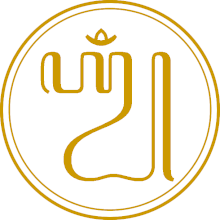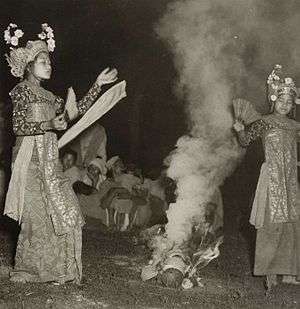Hyang
A hyang (Kawi, Javanese, Sundanese, and Balinese) is an unseen spiritual entity that has supernatural power in ancient Indonesian mythology.[1] This spirit can be either divine or ancestral. The reverence for this spiritual entity can be found in Sunda Wiwitan, Kejawen, and Balinese Hinduism. In the modern Indonesian, this term tends to be associated with gods, devata, or God.[1] The realm where the hyangs reside is called kahyangan, the abode of gods, now a synonym for svarga or heaven in modern Indonesian.[2]


Hindu Balinese spiritualism describes hyang as a venerated spiritual existence that deserves special reverence. Hyang is commonly described as a sacred and luminous personal form. It is the name for a spiritual existence that has supernatural powers, portrayed like the sun in a dream. His arrival in a person's life gives contentment without a pause for a long time, which is indistinguishable between dream and reality. Indonesians generally recognize this term to refer the cause of beauty, the cause of all existence (creator), or simply to refer to God.[1]
In Kejawen Javanese spiritualism, the concept of the one and only God almighty is described as Sang Hyang Tunggal or Sang Hyang Wenang. Raden Ngabehi Ranggawarsita in his book, Paramayoga, detailed the names and designations for Javanese concept of God as the objective of worship, including Sang Hyang Suksma Kawekas, Sang Hyang Suksma Wisesa, Sang Hyang Amurbeng Rat, Sang Hyang Sidhem Permanem, Sang Hyang Maha Luhur, Sang Hyang Wisesaning Tunggal, Sang Hyang Wenanging Jagad, Sang Hyang Maha Tinggi, Sang Hyang Manon, Sang Hyang Maha Sidhi, Sang Hyang Warmana, Sang Hyang Atmaweda, etc.[3]
Origin
The term "hyang", now widely associated with Balinese Hinduism, developed in ancient Java and Bali more than a millennium ago. However, this term actually has an older origin; it has its root in the indigenous animism and dynamism beliefs of Austronesian people that inhabit the Indonesian archipelago.[4] Native pre-Hindu, pre-Buddhist, and pre-Islamic Indonesians venerated and revered ancestral spirits. They also believed that some spirits may inhabit certain places such as large trees, stones, forests, mountains, or any sacred place. The "hyang" concept indigenously developed in the archipelago and is not considered to have originated from Indian dharmic religions.
Before the adoption of Hinduism, Buddhism and Islam, the natives of the Indonesian archipelago believed in powerful but unseen spiritual entities that can be both benevolent or malevolent. They also believed that the deceased ancestor is not gone away or disappeared completely. The ancestral spirit may gain god-like spiritual power and remain involved in their offspring's worldly affairs. That is why the veneration and reverence to honor ancestors is an important element in the belief system of native ethnic groups, such as Nias, Dayak, Toraja, Papuan ethnic groups, as well as many ethnic groups in Indonesia.
In ancient Sundanese, Javanese, and Balinese society, this unseen spiritual entity is identified as "hyang". These ancestral divine spirits are believed to inhabit high places, such as mountains, hills, and volcanoes. These mountainous regions are considered sacred realms, as the abode of gods and the resting place for the soul of the ancestors.
Several ancient Indonesian inscriptions dated from the Hindu-Buddhist period (8th to 15th century) mention hyang either as the name of sanctuary or the name of deity revered in that temple.[5]
Etymology

In Sundanese, the term "nga-hyang" means "disappear" or "unseen". It is suggested that the word "hyang" has linguistic relation with the Malay word: "hilang" which means "disappear". In its development, the term "hyang" become the root word for many terms that still known and used in modern Indonesian:
- Reverence. If the word "hyang" is attached with prefixes attribute Sang-, Dang-, Ra-; to form the word Sanghyang, Danghyang, or Rahyang, it is meant to honor or revere gods or the deceased ancestors. For example, Sanghyang Sri Pohaci and Sang Hyang Widhi[1] refer to gods, while the stylized name Rahyang Dewa Niskala refer to the name of late king of Sunda kingdom. The term Danghyang, Dhanyang, or Danyang is refer to the guardian spirits of certain sacred or haunted places. The name of Srivijayan empire founder, Dapunta Hyang Sri Jayanasa, also contained the name "hyang" which suggested that he possessed supernatural power.
- Place. Kahyangan — later kayangan, from the word ka-hyang-an — is the realm where hyangs resides. Because of the belief that hyang prefer high places, some mountainous regions is considered as the abode of hyang. For example, Parahyangan refer to mountainous region of West Java. Originated from combined words para-hyang-an; para indicate plural, while the suffix -an shows the place, so Parahyangan means the abode of hyangs. The term kahyangan is also used as the type of Pura or Balinese temple. Pura kahyangan jagad is Balinese temple that located in mountainous region as the counterparts of pura segara; Balinese temple located by the sea.[6] Dieng Plateau in Central Java also shared the same origin, it is from the combined words di-hyang which also means "hyang's place".
- Activity. The word sembahyang in Malay is synonymous with the Islamic salat ritual.[7] It actually originated from the combined word sembah-hyang which means "worship the hyang".[8] The Balinese Sanghyang Dedari sacred dance involved some pre-pubescent girls dances in trance condition. Through complex rituals to summons the hyangs spirits, it is believed that the spirits possessed the girls and made them unconsciously dance with complex movements.[9] Sanghyang Jaran is Balinese name for Kuda Lumping dance that also involving performer being entranced by spirit.
Characteristics
Hyang are said to only move in straight lines. Accordingly, traditional Balinese buildings have a wall called an aling-aling just inside the doorway, which keeps the spirits out because they only move in straight lines, and hence bounce off.[10] Similar walls can be seen at the entrance of some Javanese cemeteries. Parallel beliefs are found in other spiritual traditions, as in British corpse roads.
Hyang in religions in Indonesia
The concept of hyang for several religions in Indonesia can be concluded as follows:
- Kapitayan: It is Sang Hyang Taya almighty god that cannot be visualized but can be felt and revealed.[11]
- Hindu: It is Sang Hyang Widhi almighty god, the source of dharma brought by the gods
- Buddha: It is Sanghyang Adi Buddha the law of nature that continues to exist, a god that cannot be forgotten, where his damma was discovered by Buddha Gautama
- Islam: according to the teachings of Sunan Kalijaga Sang Hyang is the ancestor of the archipelago of Sang Hyang Adam, Sang Hyang Sita (Prophet Seth), Sang Hyang Wanuh (Prophet Noah), Sang Hyang Jawith (Japhet son of Noah), Sang Hyang Jawana (progenitor of the prophet), Sang Hyang Jawata (progenitor of the Deva), Sang Hyang Bathara Guru, Sang Hyang Ismaya, Sang Hyang Bathara Wisnu, and so on until the deceased parents are personified as the spiritual entity united with Sang Hyang.
See also
- Aitu
- Anito
- Atua
- Hanitu
- Hantu
- Kaharingan
- Kami, similar concept in Japanese Shinto faith
- Kupua
- Taotao Mona
References
- "Penjelasan Lengkap Acintya (Sang Hyang Widhi atau Sang Hyang Tunggal) - Mantra Hindu Bali". Mantra Hindu Bali (in Indonesian). 2015-12-17. Retrieved 2018-07-13.
- Setiawan, Ebta. "Arti kata kahyangan - Kamus Besar Bahasa Indonesia (KBBI) Online". kbbi.web.id. Retrieved 2018-07-13.
- Fadhil Nugroho Adi (2018-08-23). "Konsep Ketuhanan Menurut Ajaran Kejawen - suaramerdeka.com". www.suaramerdeka.com (in Indonesian). Retrieved 2020-04-21.
- Waluyo; Suwardi; Agung Feryanto; Tri Haryanto (1977). Ilmu Pengetahuan Sosial (in Indonesian). Grasindo. p. 149. ISBN 978-979-462-904-8.
- Soekmono, R. (1995). The Javanese Candi: Function and Meaning. BRILL. ISBN 9004102159.
- "Pura Kahyangan Jagat – Babadbali". new.babadbali.com (in Indonesian). Retrieved 2018-07-13.
- ""sembahyang" - Maklumat Kata". Pusat Rujukan Persuratan Melayu. Dewan Bahasa dan Pustaka Malaysia. Retrieved 13 June 2018.
- "Sembahyang" (in Indonesian). Kamus Besar Bahasa Indonesia (KBBI). Retrieved 28 May 2015.
- Khoiri, Agniya. "Jejak Terakhir Sanghyang Dedari, Tari Sakral di Bali". hiburan (in Indonesian). Retrieved 2018-07-13.
- Bali Religion Archived 2010-07-04 at the Wayback Machine
- Kompasiana.com. "Membuka Tabir Kapitayan, "Agama Kuna" di Tanah Jawa". KOMPASIANA (in Indonesian). Retrieved 2020-04-21.